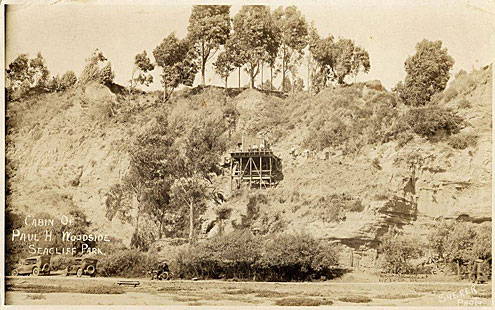By Kevin Newhouse

The stories you often tell in a quieter voice and not around the faint of heart. I like to refer to these stories as “the dark side of history.” Over the next couple of months I would like to share some of these stories with you. These are definitely not feel good stories, but nevertheless they are part of our history and I feel like they must be told and remembered. You have been warned. Read on at your own discretion.
Our first look into the dark side of history takes place at Seacliff Beach in 1925. This was during the early stages of development by the Seacliff Company. Their plan was to develop the area into a country club resort where tourists could spend their days swimming, playing golf, tennis, and polo, all while admiring the beauty of the Monterey Bay.
Prior to this development, the high bluffs behind present day Seacliff Beach were mostly used for crops and were relatively undisturbed. This venture was a major change for the area and was the beginning of the tourism industry that still exists today. However, not everyone was excited about what was happening.
Woodside was more than just a little bit quirky though. In fact, in May 1918, he had been arrested in Solano County and tried for insanity. He was not found insane enough to be committed to an asylum but was told to voluntarily go to the Napa state hospital for treatment, which he never did. Instead he left town and eventually ended up in Aptos.
Mr. Woodside’s presence in the heart of this new development was a problem for the Seacliff Company. Even though it was his land and he was living there first, they wanted him gone. He was not exactly part of the high-end country club lifestyle they were trying to create.
William Morgan, President of the Seacliff Company, attempted many times to persuade Woodside to sell his property but was never successful. When asked how much he wanted for his land, Woodside responded, “a trillion dollars.”
He not only refused to sell his land, but also started showing signs of increased violent behavior towards anyone who came near him. He began to appear with a sawed-off shotgun and would yell threats either above the cliff or down on the beach to shoot or blow up anyone who came upon his property. Fearing violence, Morgan asked the sheriff’s department for assistance. Ultimately Judge Harry Bias issued an arrest warrant charging Woodside with disturbing the peace.
On September 5, 1925, shortly after noon, Sheriff Howard Trafton and Undersheriff R.H. Roundtree arrived at Woodside’s cabin in an attempt to deliver that warrant. Woodside had been anticipating their arrival and sat crouched in his cabin with a shotgun pointed right at the door. Trafton entered the cabin and after a short talk, he convinced Woodside to put his gun down. However, when Trafton attempted to take it away, a fight ensued.
As the pair grappled, Roundtree burst into the cabin and was able to handcuff Woodside’s left wrist. Woodside, exuding super-human strength, overpowered both Trafton and Roundtree. He grabbed Trafton’s revolver from its holster and sent a bullet into the sheriff’s body. Woodside then turned the weapon on Roundtree and fired two shots killing him almost instantly.
Although extremely wounded, Sheriff Trafton battled on, again getting possession of his weapon, and fired a bullet into Woodside’s head, killing him.
Sherriff Trafton, although weak from blood loss, managed to crawl up the steep incline to the top of the cliff leaving a trail of blood. Apparently, it was obvious where he had stopped to rest due to the heavy saturation of blood.
He was taken to the hospital and fought for his life long enough to be able to tell the details of the events that took place. He died later that night. If he too had died at the scene, we would have never known about what happened in Woodside’s cabin.
A search of the cabin turned up 12 homemade bombs, 14 sticks of dynamite, and 300 shotgun shells. A few days later 6 more bombs were found on his property. There was a fear that unfound explosives were still on his property so Sheriff J.B. Holohan and a squad of deputies obtained permission from the late Paul Woodside’s mother to burn the cabin down and to blow up a cave on his property so that no harm could come to children playing on the hillside.
All in all, 3 men died as a result of 6 bullets (all fired from the sheriff’s gun). Nobody knows what Woodside’s plans were for the weapons he was stockpiling and thankfully nobody would ever find out.
•••
For more information about the Aptos History Museum, upcoming events, or becoming a member of the museum, please visit www.aptoshistory.org and follow us on Facebook and Instagram @aptos_history_museum.